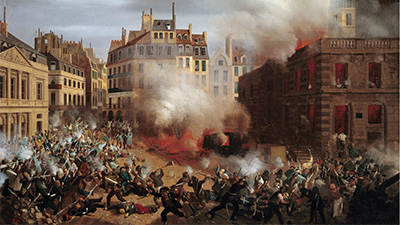Revolutions c. 1750 to 1900 CE
Teacher Resources
Driving Question: What were the key revolutions of the period c. 1750-1900 CE, and how did they shape the modern world?
Revolutionary ideas grew out of a strong desire to change the way society, government, and power were structured. These ideas questioned traditional beliefs and called for new values that addressed injustice and inequality. Enlightenment thinkers were especially important in shaping new ideas, promoting concepts such as individual rights, equality, and government by the people. Together with economic struggles and political complaints, these new revolutionary ideas helped inspire movements to break down unfair systems and build more just and inclusive ones.
Learning Objectives
- Learn about new notions of sovereignty and how these ideas affected different states along the Atlantic coasts and throughout the world at varying degrees.
- Evaluate the era of revolutions using the AP® themes.
Vocab Terms:
- imperialism
- industrialization
- liberal
- nationalism
- socialism
- sovereignty
Opener: Unit 5 Overview
To teach this lesson step, refer to page 3 of the Lesson 5.0 Teaching Guide.
From capitalism to suffrage, preview Unit 5 through this vocabulary exercise.
Unit 5 Overview
To teach this lesson step, refer to page 3 of the Lesson 5.0 Teaching Guide.
Check out our Video Guide for suggestions on incorporating videos in the classroom.
By the 20th century, European empires like Russia began recognizing Japan as a major rival. But the answer to how Japan—a decentralized and unindustrialized country run by a military dictator—managed to become a powerful contender to such empires lies within the history of the political and industrial revolutions of the long 19th century.
-
Guiding Questions
-
Before you watch
Preview the questions below, and then review the transcript.
While you watch
Look for answers to these questions:
- Why was the Japanese victory over the Russians shocking?
- What was the most significant change in governance from the sixteenth century to the early nineteenth century?
- Where did industrialization begin and how did it change society?
- Why is it important to study revolutions through social hierarchies?
- How did national sovereignty and nationalism reshape governance?
- How do the themes of technology and innovation, economic systems, humans and the environment, and governance relate to industrialization?
- How did the Meiji Restoration transform Japan?
After you watch
Respond to the following question:
- This video covers a lot of changes, many of which relate to the governance theme. But what were some things that stayed the same? What were two continuities in governance in this period?
Key Ideas
Unit 5 Introduction: Revolutions c. 1750 to 1900
To teach this lesson step, refer to page 4 of the Lesson 5.0 Teaching Guide.
Take a look at our Reading Guide to learn about the Three-Step Reading approach.
The period from c. 1750 to 1900 is often called an age of revolution—but what does that mean? In what ways was this period revolutionary? In this introduction to Unit 5, you’ll find out!
-
Guiding Questions
-
Before your read
Preview the questions below, and then skim the article. Be sure to look at the section headings and any images.
After you read
Look for answers to these questions:
- What evidence does the author provide to support the claim that 1750 to 1900 was an age of revolution?
- What new ideas helped create the political revolutions at the start of this period?
- What innovation started off the Industrial Revolution? Why was this change so significant?
- According to the article, what are the effects of capitalism?
While you read
Respond to the following questions:
- Which of the revolutions described in this introduction do you think offered the biggest break with what had gone before? Why?
- In Unit 4 you encountered the Columbian Exchange. Did the Columbian Exchange lead to the Industrial Revolution? Why or why not?
Closer: Unit 5 Overview
To teach this lesson step, refer to page 6 of the Lesson 5.0 Teaching Guide.
The Themes Notebook works much like the Unit Notebook in other OER Project courses. Explore this discussion on Unit Problem and Vocab for ideas on bringing this informal writing routine into the classroom.
Have you noticed a theme for the start of each unit? Yes, it’s time again to check out the Themes Notebook to keep connected to connections you make about the material you’ve studied!



